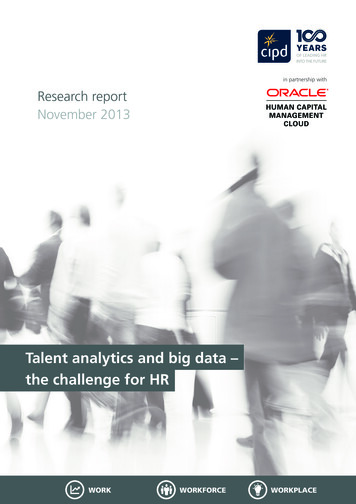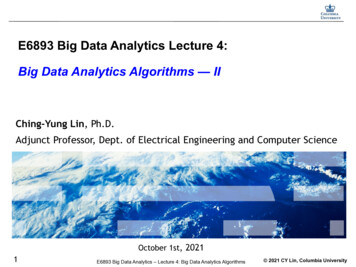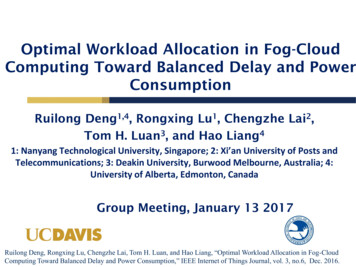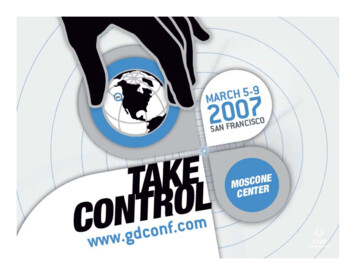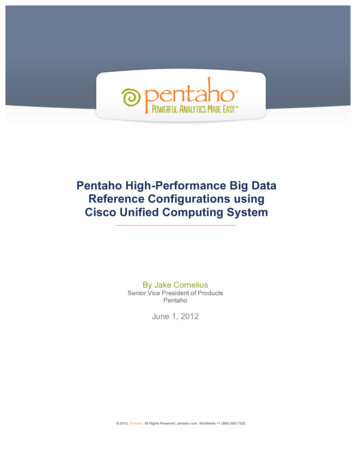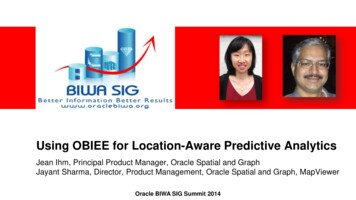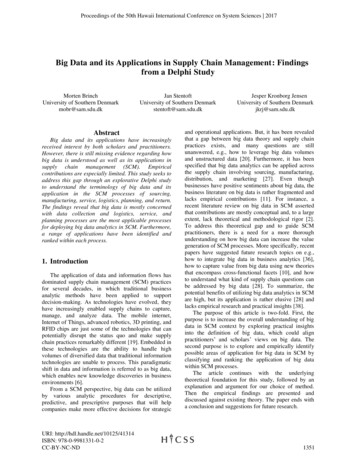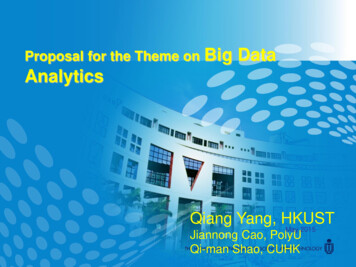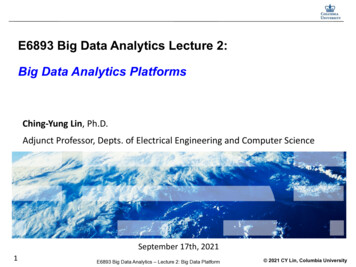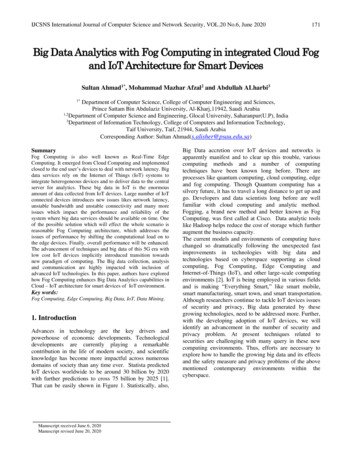
Transcription
IJCSNS International Journal of Computer Science and Network Security, VOL.20 No.6, June 2020171Big Data Analytics with Fog Computing in integrated Cloud Fogand IoT Architecture for Smart DevicesSultan Ahmad1*, Mohammad Mazhar Afzal2 and Abdullah ALharbi31*Department of Computer Science, College of Computer Engineering and Sciences,Prince Sattam Bin Abdulaziz University, Al-Kharj,11942, Saudi Arabia1,2Department of Computer Science and Engineering, Glocal University, Saharanpur(U.P), India3Department of Information Technology, College of Computers and Information Technology,Taif University, Taif, 21944, Saudi ArabiaCorresponding Author: Sultan Ahmad(s.alisher@psau.edu.sa)SummaryFog Computing is also well known as Real-Time EdgeComputing. It emerged from Cloud Computing and implementedclosed to the end user’s devices to deal with network latency. Bigdata services rely on the Internet of Things (IoT) systems tointegrate heterogeneous devices and to deliver data to the centralserver for analytics. These big data in IoT is the enormousamount of data collected from IoT devices. Large number of IoTconnected devices introduces new issues likes network latency,unstable bandwidth and unstable connectivity and many moreissues which impact the performance and reliability of thesystem where big data services should be available on time. Oneof the possible solution which will effect the whole scenario isreasonable Fog Computing architecture, which addresses theissues of performance by shifting the computational load on tothe edge devices. Finally, overall performance will be enhanced.The advancement of techniques and big data of this 5G era withlow cost IoT devices implicitly introduced transition towardsnew paradigm of computing. The Big data collection, analysisand communication are highly impacted with inclusion ofadvanced IoT technologies. In this paper, authors have exploredhow Fog Computing enhances Big Data Analytics capabilities inCloud – IoT architecture for smart devices of IoT environment.Key words:Fog Computing, Edge Computing, Big Data, IoT, Data Mining.1. IntroductionAdvances in technology are the key drivers andpowerhouse of economic developments. Technologicaldevelopments are currently playing a remarkablecontribution in the life of modern society, and scientificknowledge has become more impactful across numerousdomains of society than any time ever. Statista predictedIoT devices worldwide to be around 30 billion by 2020with further predictions to cross 75 billion by 2025 [1].That can be easily shown in Figure 1. Statistically, also,Manuscript received June 6, 2020Manuscript revised June 20, 2020Big Data accretion over IoT devices and networks isapparently manifest and to clear up this trouble, variouscomputing methods and a number of computingtechniques have been known long before. There areprocesses like quantum computing, cloud computing, edgeand fog computing. Though Quantum computing has asilvery future, it has to travel a long distance to get up andgo. Developers and data scientists long before are wellfamiliar with cloud computing and analytic method.Fogging, a brand new method and better known as FogComputing, was first called at Cisco. Data analytic toolslike Hadoop helps reduce the cost of storage which furtheraugment the business capacity.The current models and environments of computing havechanged so dramatically following the unexpected fastimprovements in technologies with big data andtechnologies based on cyberspace supporting as cloudcomputing, Fog Computing, Edge Computing andInternet-of-Things (IoT), and other large-scale computingenvironments [2]. IoT is being employed in various fieldsand is making “Everything Smart,” like smart mobile,smart manufacturing, smart town, and smart transportation.Although researchers continue to tackle IoT devices issuesof security and privacy, Big data generated by thesegrowing technologies, need to be addressed more. Further,with the developing adoption of IoT devices, we willidentify an advancement in the number of security andprivacy problem. At present techniques related tosecurities are challenging with many query in these newcomputing environments. Thus, efforts are necessary toexplore how to handle the growing big data and its effectsand the safety measure and privacy problems of the abovementioned contemporary environments within thecyberspace.
172IJCSNS International Journal of Computer Science and Network Security, VOL.20 No.6, June 2020Fig. 1 No. of connected Devices worldwide in IoT (Source - Statista ,2019).In this paper, the authors are also exploring the effects ofFog Computing and other computing technologies on thegrowing Big Data, Data Mining and its analyticstechniques. Many aspects of data processing, storagesecurity, and retrieval techniques are being affected andneed to improve the methodologies to handle themproperly in regulation to correct the effectualness andsecurity of data storage and renascence. “Fog has someextraordinary characteristics which make it moreapplicable for the applications demanding low latency,mobility support, real-time interactions, online analytics,and interplay with the cloud” [3].2. Related WorksThe brand new Computing paradigms might achievablehelptomeet QoSrequirements,applicationsynchronization and revelation. Related problems likesstorage restriction, and Management structure relatedissues are discussed in too many works.Segall, R et al.(2018), has given visualization of vast datain fog computing and cloud computing in IoTenvironment [4]. They have done the case study for actualdata from fatality analysis reporting system (FARS)handled by the National High-way Traffic SafetyAdministration (NHTSA) of the United States Departmentof Transportation (USDoT). The challenges and scope ofopportunity in using Big Data along Fog Computing hasbeen also explain in their work. In further developmentSegall, R et al.(2019), have explored problems along withexplanation of High Performance Computing (HPC)systems, environment for storage systems for dataintensive applications, storage arrangement and storagestructure for Big Data with Fog-to-cloud infrastructure [5].Mehdipour, F et al. (2019), have explained in their bookchapter about how to deploy Fog Engine for vast dataanalytics[6]. The FE gives as a premise data analyticsalong with the potentiality for Internet‐of‐Things (IoT)devices to interact with each other and with the cloud.They have elaborated system prototype and theirevaluation with the help of two case studies. FogComputing implementation in IoT healthcare applicationhas been performed and evaluated by Mutlaq et al. (2018)in their work [7]. They explained latency benefit of fogcomputing over cloud computing with simulation that isan important aspect in real time application like healthcare.T. Kudo (2018), has proposed the distributed data model[8]. In this model of Fog Computing, it has classified threecategories of data: sensor's original data, extracted data,and its analysis result data. He used distributed databaseconcept and created this model on Fog and Cloud node. Inhis work out, it is being exposed that the data volume to be
IJCSNS International Journal of Computer Science and Network Security, VOL.20 No.6, June 2020transferred generally to the cloud server can be decreasedby using this model.Chang et al. [9] recommended the Indie Fog frameworkthat can be expand in many ways. It can utilize customer’network devices for giving Fog computing for IoT devices.It works for processing of data gathered from sensors andother devices. The framework Indie Fog would beexpanding in static sensor devices and give the infrastructure for different services such as prompt dataacquisition and processing.Gupta H et. al. (2016), have developed a modelling andsimulation/duplication tool named ‘ iFogSim’ that can beused to do modelling and simulation/duplication of fogcomputing environments in order to evaluate previsingand management in edge and cloud resources in variousconditions[10]. It calculates performance metrics andreplicate edge devices, cloud datacenters, sensors, networklinks, data streams, and stream-processing applications.In another work, Jinlai Xu et. al. (2017) have proposed amodel named ‘Zenith’ for computing resources allocationin Edge Computing and internet of things infrastructure[11]. They evaluated their model with many experimentsin order to check the effectiveness, scalability andperformance efficiency. Farshad F et. al. (2018) havepurposed their work and analyzed the concern and issuesin Internet of Things Technologies for healthcareapplications specially tele-health care application. Thesefunctions consist of wearable and body sensors,progressive pervasive healthcare systems, and the VastData analytics required to inform these devices.173find sets of oftentimes occurring items in IoT domains andassociation among them. Supervised Learning is a methodto develop models from existing data for the purpose ofclassification and prediction. Big Data technologies. The new implementation of data analytics inorganization widely enhanced and pushed the technologiesadvancement with time. Most of the commercialorganizations focus on customer relationships andconsumer applications for business [13]. As per thisscenario, Big Data Analytics can be categorized in threecategories as below Figure 2.3. Big Data and Data MiningFig. 2 Different categories of Big Data AnalyticsBig Data are in huge capacity being collected fromhomogeneous devices or multiple types of devices. Thesedevices could be sensors in IoT, standard PCs and regularembedded devices. These big data include valuableinformation and useful knowledge. These data as invarious forms and types used for further analysis andknowledge extraction. These data can be further categoriesas precise, unprecise and uncertain.Data Mining tools and techniques are used in collectingand processing of Big data. Data mining is a process todiscover the implicit useful data which were earlierunknown. Data mining on the Big Data, generated byInternet of Things devices helps to discover patterns forIoT applications of IoT verticals likes smart cities, smarthome, smart industries and many mores analytics. It helpsto find and identify different communities and groups onvarious social networking sites and applications.The main famous data mining process are Frequent Patternrecognition and Supervised Learning. Pattern recognitionenables us to find frequent appearance of data set and theircorrelation in IoT environment. Pattern Mining is help toBig Data analysis is interdisciplinary domain which isformed by integrating machine learning(ML), DataMining(DM), NLP (natural language processing) andstatistics. These data are excavated, handled and combinedfor better analysis for the businesses. These methods andtechnologies are being used nowadays in great enterprisesand multinational companies in different ways fordifferent purposes.4. Fog Computing and its benefits towardsData AnalyticsFog Computing, implemented as a distributed systemwhich Big Data collection, processing, and distribution asits components. In this environment edge nodes arecapable of collecting, processing large quantity of datalocally [14]. This makes possible to minimize the load ofremote server and minimizing the bandwidth overhead of
174IJCSNS International Journal of Computer Science and Network Security, VOL.20 No.6, June 2020communication channel. In the middle layer of thisarchitecture, cloudlets work as mini data center thataccomplish major data processing task to support the IoTdevices and applications which needs real time, lowlatency data processing [15]. Major data storage andprocessing load are shifted to Fog, which is acting asintelligent gateway to the cloud server.Fog Computing can be performing data mining task suchas pattern recognition that results in high efficiency andlow latency. In this approach data is stored on IoT devicesto discover regular patterns and further integrating thispattern to generate a global candidate pattern.The main advantages of Fog Computing are as follow:1) Optimum utilization of edge network resourcesinstead of wide cloud network.2) Processing and storage are made near to endusers.3) Storage and Processing are at IoT devices ormiddle layer between edge and central datacenters.4) It minimizes the latency problem.5) It can efficiently work on low bandwidth.6) Data security and reliability are improved in FogComputing.7) Improved users experience with low responsetimes.8) Power efficiency with Bluetooth, Zigbee or Zwave.The data processing steps and process in Cloud-Fog-IoTbased infrastructure can be seen in the below given Figure3. IoT devices which are sensor based collects the data.These data in aggregated and collaborative way, aredelivered to the edge and fog server. Here data areprocessed locally properly. The data are being indexed andmined in order to get efficient multiple search and patternrecognition. To ensure future security data are beingencrypted with secure algorithm by proxy server beforesending it to the Cloud. The details subtasks in differentphases can be shown in the given Figure 3.Once the data user search the required data edge serversend a query to the cloud server that search it in encryptedindex data structure. Cloud server is responsible to storeall the data and do the search operation for particular data,requested by data user. Finally, Cloud server send theencrypted search result to user that can decrypt theencrypted data based on their secret keys.Fig. 3 Data Collection, Storage, retrieval and Mining process in CloudFog-IoT ArchitectureThe Fog Computing is needed to help multipleconventions, for example, ZigBee, WiFi, 2G/3G/4G/5G,WiMax, 6LOWPAN and so on, whereas Cloud is forhelping TCP/IP. The pushing service incorporatesreceiving the knowledge and converting the information.The end devices pass on information to the Fog later theyproduce the information [16].Integrating cloud computing and IoT devices reduces thecost and improve the efficiency of the data analysis in IoTenvironment. Further, scalability of devices is alsoaccomplished in the system. But this approach alsoinherits the limitation and existing security and privacyissues due to its huge distributed infrastructure [17]. Thatis benefits of fog computing over cloud computingparadigm.5. Fog verses Cloud in aspect of Big DataIt is widely accepted that Fog Computing can replacecloud computing and it is merely imagination and can
IJCSNS International Journal of Computer Science and Network Security, VOL.20 No.6, June 2020replace one another or take one another place. Fogcomputing implies an ignorant approach and is overlookedby the developers that they have a fine advantage when itis used for the local application based on IoT networks[18]. Whereas cloud computing also poses an advantagefor the same but the volume of Big Data has a large175potential in cloud networks and the following is welldemarcated and circulated in modules/supervised in fogcomputing.Table 1: Comparison of Cloud and Fog Computing for Big DataCharacteristicsFog ComputingHierarchy of ProcessingData are being analyzed locallyProcessing TechniqueComputing PowerLatencyStorage of DataLifetime of DataFault-ToleranceIn-stream processingGFLOPSMillisecondsGigabytesHours or DaysVery HighHeterogeneous (e.g., CPU, FPGA, GPU)and Fine-grainedOnly exists on demandLimited by the number of Fog-engines inthe vicinityMaybe Mobile (e.g. in the car)Pay onceBattery-powered/ElectricityProcessing Resources and GranularityVersatilityProvisioning ProcessNodes MobilityPricing PolicyPower ModelIn cloud computing, the structure of the data is placed faraway from the consumer devices whereas in the fogcomputing the data is structured and stored in the shape ofmillions of tiny nodes stored adjacent to the customerdevices. A comparison table is demonstrated in givenbelow Table 1. Moreover, if one compares cloudcomputing and fog computing structures, cloud computinghas an extensive network, large distant from end deviceswhereas fog computing works as a medium between datacenters and hardware and it is close to end-users.Cloud computing contact with devices directly but onlywithout the fog layer, which sometimes consumes time.However, fog computing contacts with devices directlyand it provides is real-time feedback but it works in theproximity of the devices with tiny little nodes while cloudcomputing works with the remote servers which is why itis time taking.Fog computing is tiny in size as compare to cloudcomputing, and also fog computing has low storagecapacity and power. Fog computing works on millions oftiny nodes which are linked inside and distinct ascompared to cloud computing with fewer nodes. Smallterm data analysis can be done by the use of fogcomputing because it responds immediately but cloudcomputing is meant for long term data analysis and itprovides passive responses. Because of the number ofnodes in conducting data, fog computing has minorlatency whereas cloud computing works on the base offew nodes and has to analyze Big Data results in incurringCloud ComputingData are being analyzed at datacentersBatch eneous (Data center) andCoarse-grainedIntangible ncy. Fog computing is feasible in a protocol likeBluetooth, Zigbee and so on, even if it faces the power cutwhile in contrast cloud computing cannot even imaginehandling data with the power supply. Consequently, fogcomputing is a far safer system to store the data throughthe use of tiny nodes or end-devices and the use of cloudcomputing is not secure for data as it uses the cloudsources that need a constant power supply and is timetaking.6. ConclusionWith more IoT devices, the Big Data is becoming moreintense in amount and to manage it. But, as there is distinctcomputing potential to every method, quite distinct fromeach other. Every lock has its key and similarly, every BigData center has a distinct computing way for it. The fieldof Data analytics and computing has vast capabilities asthere are tons of Data mined each hour through differentIoT devices all over the world. There are new choices forresearch and analysis using data analytics. A lot of firmsare spending in developing computing potentiality of theirown to cope up with large amounts of Big Data and itsanalytics. Thus, if any institution is data-driven or it has anIoT based application, they require to have a computingsolution to their data storage as data analytics can assistthem to understand, customer purchase patterns, thecapability pool of consumer, Market surveys, competitor
IJCSNS International Journal of Computer Science and Network Security, VOL.20 No.6, June 2020176strategies, and strategic marketing fronts. If their aim is forlong-term analysis of data, cloud computing is the rightway to go, with cloud point of supply at its core. But, ifusers are searching for intensify user experiences andimmediate real-time responsive, computation needs, theyshould go for Fog Computing.[12]AcknowledgmentsThe authors would like to thank the Deanship of ScientificResearch at Prince Sattam Bin Abdulaziz University,Alkharj, Saudi Arabia for the ot-number-ofconnected-devices-worldwide/(Access Available on 11Dec,2019)Ahmad S., Afzal M.M. (2020) Deployment of Fog and EdgeComputing in IoT for Cyber-Physical Infrastructures in the5G Era. In: Karrupusamy P., Chen J., Shi Y. (eds)Sustainable Communication Networks and Application.ICSCN 2019. Lecture Notes on Data Engineering andCommunications Technologies, vol 39. Springer, ChamA. V. Dastjerdi and R. Buyya, "Fog Computing: Helpingthe Internet of Things Realize Its Potential," in Computer,vol.49,no.8, pp. 112-116, Aug. 2016.doi: 10.1109/MC.2016.245Segall, R. S., & Niu, G. (2018). Big Data and ItsVisualization With Fog Computing. International Journal 018070102Segall, Richard & Cook, Jeffrey & Niu, Gao. (2019).Overview of Big Data-Intensive Storage and itsTechnologies for Cloud and Fog Computing. 8/IJFC.2019010104.Mehdipour, F., Javadi, B., Mahanti, A., & Ramirez-Prado,G. (2019). Fog Computing Realization for Big DataAnalytics. Fog and Edge Computing: Principles andParadigms, 259-290.A.A. Mutlag, M.K.A. Ghani, N. Arunkumar, M.A.Mohamed, O. Mohd.(2018), Enabling technologies for fogcomputing in healthcare IoT systems, Future .1016/j.future.2018.07.049T. Kudo, "Fog Computing with Distributed Database (2018),IEEE 32nd International Conference on AdvancedInformation Networking and Applications (AINA), Krakow,2018, pp. 623-630. doi: 10.1109/AINA.2018.00096C. Chang, S. Narayana Srirama and R. Buyya, Indie Fog:An Efficient FogComputing Infrastructure for the Internetof Things, in Computer, Vol. 50, no. 9, pp. 92-98, 2017Gupta H, Dastjerdi AV, Ghosh SK, Buyya R (2016)ifogsim: A toolkit for modeling and simulation of resourcemanagement techniques in internet of things, edge and fogcomputing environments. arXiv:abs/1606.02007Xu, J.; Palanisamy, B.; Ludwig, H.; Wang, Q. Zenith:Utility-Aware Resource Allocation for Edge Computing, In[13][14][15][16][17][18]Proceedings of the IEEE International Conference on EdgeComputing (EDGE), Honolulu, HI, USA, 25–30 June 2017;pp. 47–54.Farshad Firouzi, Amir M. Rahmani, K. Mankodiya, M.Badaroglu, G.V. Merrett, P. Wong, Bahar Farahani,Internet-of-Things and big data for smarter healthcare: Fromdevice to architecture, applications and analytics, FutureGeneration Computer Systems, Volume 78, Part 2, .1016/j.future.2017.09.016Ajit Singh, Sultan Ahmad, Mohammad ImdadulHaque(2019), “Big Data Science and EXASOL as Big DataAnalytics tool”, International Journal of InnovativeTechnology and Exploring Engineering (IJITEE) ISSN:2278-3075, Volume-8, Issue-9S,pp-933-937, July 2019W. Shi and S. Dustdar, "The Promise of Edge Computing,"in Computer, vol. 49, no. 5, pp. 78-81, May 2016.doi:10.1109/MC.2016.145M. Y. uddin and S. Ahmad, "A Review on Edge to Cloud:Paradigm Shift from Large Data Centers to Small Centers ofData Everywhere," 2020 International Conference onInventive Computation Technologies (ICICT), 48043.2020.9112457.Malik, Babur & Mahmood, Faisal & Shahzad, Sohail &Arif, Muhammad & Khan, Waseem & Ilyas, Sadaf &Hassan, Muhammad. (2018). From cloud computing to fogcomputing in Healthcare big data. MATEC Web 3011.S. Ahmad, Afzal M.M., Review of Assured Data DeletionMechanism in Cloud Computing, International Journal ofEngineering & Technology (UAE), Vol 7, No 4.5 (2018),Special Issue 5, 2018.Ling C, Lifang L, Xiaogang Q, Gengzhong Z (2017)Cooperation forwarding data gathering strategy of wirelesssensor networks. Int J Grid Util Comput 04/IJGUC.2017.10003009Sultan Ahmad, is currently working asLecturer in Department of ComputerScience,CollegeofComputerEngineering and Sciences, PrinceSattam Bin Abdulaziz University,Alkharj, Saudi Arabia. He has a uniqueblend of education and experience.He has received his Master of Computer Science andApplications from the prestigious Aligarh Muslim University,India with distinction marks. He has graduated in ComputerScience and Applications in 2002 from Patna University, India.
IJCSNS International Journal of Computer Science and Network Security, VOL.20 No.6, June 2020He has more than 12 years of teaching and research experience.His research and teaching interests include Cloud Computing,Big Data, Machine Learning and Internet of Things. He haspresented his research papers in many national and internationalconferences and published research papers in many peerreviewed reputed journals.Mohammad Mazhar Afzal, is anAssociate Professor and head of theComputer Science and EngineeringDepartment at Glocal University, wherehe has been since 2015. From 2008 to2013 he served at a GovernmentUniversity at KSA.After Completing his Masters in Computer Science in Year 1997he served at Department of Computer Science Maulana Azadcollege, Aurangabad for nearly a decade. He received his PhDfrom Dr.Babasaheb Ambedkar Marathawada UniversityAurangabad(MS). His research interests span both InternetGovernance and Network Security. Much of his work has beenon improving the understanding, design, and performance ofSecurity systems and various cryptographic techniques. In thenetworking arena, he has worked on characterizing the Internetand the World Wide Web. In addition, he is always keen onimproving and imparting modern methods of teaching andimparting knowledge. He also Served various academic bodies atdifferent capacities. Additionally, he is also working as Director(IQAC) at Glocal University.Abdullah Alharbi received the Ph.D. degree from theUniversity of Technology Sydney, Australia. He is currently anAssistant Professor with Information Technology department atTaif University. His research interests include human computerinteraction, information systems, cybersecurity and data science.177
how Fog Computing enhances Big Data Analytics capabilities in Cloud – IoT architecture for smart devices of IoT environment. Key words: Fog Computing, Edge Computing, Big Data, IoT, Data Mining. 1. Introduction Advances in technology are the key drive


